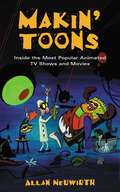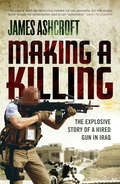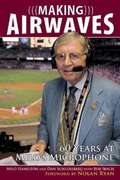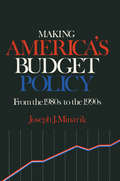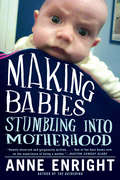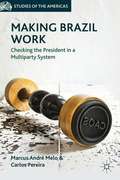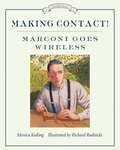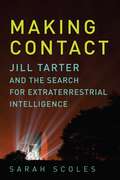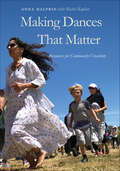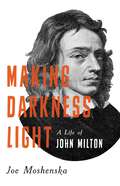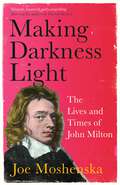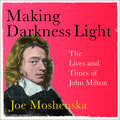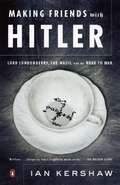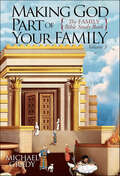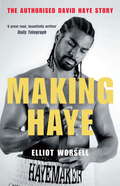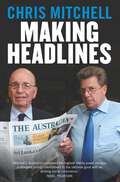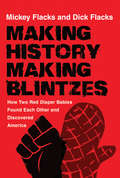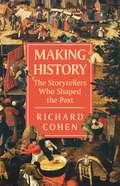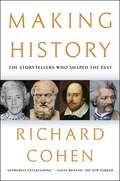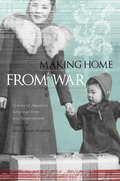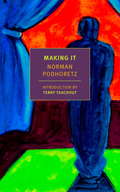- Table View
- List View
Makin' Toons: Inside the Most Popular Animated TV Shows and Movies
by Allan NeuwirthFrom the first drawing board sketch to wriggling TV character, Makin' Toons illustrates the thrills and challenges of making animated cartoon movies as told by the industry's most successful creators. Cartoon lovers everywhere will be treated to 47 personal interviews with animation artists and industry leaders ranging from Shrek director Andrew Adamson to Rugrats producer Gabor Csupo. These and dozens of other fascinating firsthand accounts chronicle the behind-the-scene antics and commercial dynamics behind such blockbusters as The Simpsons, South Park, Beauty and the Beast, and Dragon Tales, to name just a few. Author Allan Neuwirth-an accomplished animation artist and writer himself-spices the book with insightful comments, hilarious anecdotes, and a true "toon artist's" sense of humor. He also includes 75 never-before-published concept drawings, character designs, storyboards, and much more.Allworth Press, an imprint of Skyhorse Publishing, publishes a broad range of books on the visual and performing arts, with emphasis on the business of art. Our titles cover subjects such as graphic design, theater, branding, fine art, photography, interior design, writing, acting, film, how to start careers, business and legal forms, business practices, and more. While we don't aspire to publish a New York Times bestseller or a national bestseller, we are deeply committed to quality books that help creative professionals succeed and thrive. We often publish in areas overlooked by other publishers and welcome the author whose expertise can help our audience of readers.
Making A Difference in the World
by Lynne Cherry John Christopher FineA prominent children's book author and illustrator shares her life, her daily activities, her interest in environmental preservation, and her creative process, showing how all are intertwined.
Making A Killing: The Explosive Story of a Hired Gun in Iraq
by James AshcroftIn September 2003, James 'Ash' Ashcroft, a former British Infantry Captain, arrived in Iraq as a 'gun for hire'. It was the beginning of an 18-month journey into blood and chaos.In this action-packed page-turner, Ashcroft reveals the dangers of his adrenalin-fuelled life as a security contractor in Baghdad, where private soldiers outnumber non-US Coalition forces in a war that is slowly being privatised. From blow-by-blow accounts of days under mortar bombardment to revelations about life operating deep within the Iraqi community, Ashcroft shares the real, unsanitised story of the war in Iraq - and its aftermath - direct from the front line.
Making Airwaves: 60 Years at Milo's Microphone
by Milo Hamilton Dan Schlossberg Bob IbachSportscaster, Milo Hamilton, discusses his 60-year as a sports announcer, concentrating on baseball. He discusses the teams and people with whom he worked.
Making America's Budget Policy from the 1980's to the 1990's
by Joseph J. MinarikThis collection of articles traces the evolution over the 1980s of budget policy and tax reform by an architect of the Bradley tax reform bill. The articles present a chronological analysis of tax changes and the heated controversy over budget policy and the deficit. It concludes with an analysis of what the future holds. The author, currently staff director of the Joint Economic Committee of Congress, has the perspective of a fiscal expert with many years on the Washington scene.
Making Babies: Stumbling into Motherhood
by Anne EnrightA San Francisco Chronicle Lit Pick "Much of the book is astonishingly funny; the rest would break your heart." --Colm Tóibín Anne Enright is one of the most acclaimed novelists of her generation. The Gathering won the 2007 Man Booker Prize, and her follow-up novel, The Forgotten Waltz, garnered universal praise for her luminous language and deep insight into relationships. Now, in Making Babies, Enright offers a new kind of memoir: an unapologetic look at the very personal experience of becoming a mother. With a refreshing no-nonsense attitude, Enright opens up about the birth and first two years of her children's lives. Enright was married for eighteen years before she and her husband Martin, a playwright, decided to have children. Already a confident, successful writer, Enright continued to work in her native Ireland after each of her two babies was born. While each baby slept, those first two years of life, Enright wrote, in dispatches, about the mess, the glory, and the raw shock of motherhood. Here, unfiltered and irreverent, are Enright's keen reactions to the pains of pregnancy, the joys of breast milk, and the all-too-common pressures to be the "perfect" parent. Supremely observant and endlessly quizzical, Enright is never saccharine, always witty, but also deeply loving. Already a bestseller in the UK, Making Babies brings Enright's autobiographical writing to American readers for the first time. Tender and candid, it captures beautifully just what it's like for a working woman to become a mother. The result is a moving chronicle of parenthood from one of the most distinctive and gifted authors writing today.
Making Brazil Work
by Carlos Pereira Marcus André MeloThis book offers the first conceptually rigorous analysis of the political and institutional underpinnings of Brazil's recent rise. Using Brazil as a case study in multiparty presidentialism, the authors argue that Brazil's success stems from the combination of a constitutionally strong president and a robust system of checks and balances.
Making Contact!: Marconi Goes Wireless (Great Idea Series #5)
by Monica KullingThe fifth book in Tundra's Great Idea Series, Making Contact! tells the story of Guglielmo Marconi, who became the father of wireless communication. As a boy, Marconi loved science and invention. Born in 1874 in Bologna, Italy, to a wealthy family, Marconi grew up surrounded by books in his father's library. He was fascinated with radio waves and learned Morse code, the language of the telegraph. A retired telegraph operator taught him how to tap messages on the telegraph machine. At the age of twenty, Marconi realized that no one had invented a wireless telegraph. Determined to find a way to use radio waves to send wireless messages, Marconi found his calling. And, thanks to his persistence, on December 12, 1901, for the first time ever, a wireless signal traveled between two continents. The rest is history. Monica Kulling's playful, informative text, combined with the compelling illustrations of artist Richard Rudnicki, bring an amazing inventor and his times to life.
Making Contact: Jill Tarter And The Search For Extraterrestrial Intelligence
by Sarah ScolesFor anyone who has ever looked up at the night sky and wondered, "Are we alone?" A brilliant examination of the science behind the search for extraterrestrial intelligence and its pioneer, Jill Tarter, the inspiration for the main character in Carl Sagan's Contact. Jill Tarter is a pioneer, an innovator, an adventurer, and a controversial force. At a time when women weren’t encouraged to do much outside the home, Tarter ventured as far out as she could—into the three-Kelvin cold of deep space. And she hasn’t stopped investigating a subject that takes and takes without giving much back. Today, her computer's screensaver is just the text “SO…ARE WE ALONE?” This question keeps her up at night. In some ways, this is the question that keep us all up at night. We have all spent dark hours wondering about our place in it all, pondering our "aloneness," both terrestrial and cosmic. Tarter’s life and her work are not just a quest to understand life in the universe: they are a quest to understand our lives within the universe. No one has told that story, her story, until now. It all began with gazing into the night sky. All those stars were just distant suns—were any of them someone else's sun? Diving into the science, philosophy, and politics of SETI—searching for extraterrestrial intelligence—Sarah Scoles reveals the fascinating figure at the center of the final frontier of scientific investigation. This is the perfect book for anyone who has ever looked up at the night sky and wondered if we are alone in the universe.
Making Dances That Matter: Resources for Community Creativity
by Rachel Kaplan Anna HalprinAnna Halprin, vanguard postmodern dancer turned community artist and healer, has created ground-breaking dances with communities all over the world. Here, she presents her philosophy and experience, as well as step-by-step processes for bringing people together to create dances that foster individual and group well-being. At the heart of this book are accounts of two dances: the Planetary Dance, which continues to be performed throughout the world, and Circle the Earth. The Circle the Earth workshop for people living with AIDS has generated dozens of "scores" for others to adapt. In addition, the book provides a concrete guide to Halprin's celebrated Planetary Dance. Now more than 35 years old, Planetary Dance promotes peace among people and peace with the Earth. Open to everyone, it has been performed in more than 50 countries. In 1995 more than 400 participants joined her in a Planetary Dance in Berlin commemorating the fiftieth anniversary of the signing of the Potsdam Agreements, at the end of World War II. More recently, she took the Planetary Dance to Israel, bringing together Israelis and Palestinians as well as other nationalities. Throughout this book Halprin shows how dance can be a powerful tool for healing, learning and mobilizing change, and she offers insight and advice on facilitating groups. If we are to survive, Halprin argues, we must learn, experientially, how our individual stories weave together and strengthen the fabric of our collective body. Generously illustrated with photographs, charts and scores, this book will be a boon to dance therapists, educators and community artists of all types.
Making Darkness Light: A Life of John Milton
by Joe MoshenskaAn innovative and elegant new biography of John Milton from an acclaimed Oxford professorJohn Milton was once essential reading for visionaries and revolutionaries, from William Blake to Ben Franklin. Now, however, he has become a literary institution—intimidating rather than inspiring.In Making Darkness Light, Oxford professor Joe Moshenska rediscovers a poet whose rich contradictions confound his monumental image. Immersing ourselves in the rhythms and textures of Milton&’s world, we move from the music of his childhood home to his encounter with Galileo in Florence into his idiosyncratic belief system and his strange, electrifying imagination.Making Darkness Light will change the way we think about Milton, the place of his writings in his life, and his life in history. It is also a book about Milton&’s place in our times: about our relationship with the Western canon, about why and how we read, and about what happens when we let someone else&’s ideas inflect our own.
Making Darkness Light: The Lives and Times of John Milton
by Joe MoshenskaFor most of us John Milton has been consigned to the dusty pantheon of English literature, a grim puritan, sightlessly dictating his great work to an amanuensis, removed from the real world in his contemplation of higher things. But dig a little deeper and you find an extraordinary and complicated human being.Revolutionary and apologist for regicide, writer of propaganda for Cromwell's regime, defender of the English people and passionate European, scholar and lover of music and the arts - Milton was all of these things and more.Making Darkness Light shows how these complexities and contradictions played out in Milton's fascination with oppositions - Heaven and Hell, light and dark, self and other - most famously in his epic poem Paradise Lost. It explores the way such brutal contrasts define us and obscure who we really are, as the author grapples with his own sense of identity and complex relationship with Milton. Retracing Milton's footsteps through seventeenth century London, Tuscany and the Marches, he vividly brings Milton's world to life and takes a fresh look at his key works and ideas around the nature of creativity, time and freedom of expression. He also illustrates the profound influence of Milton's work on writers from William Blake to Virginia Woolf, James Joyce to Jorge Luis Borges.This is a book about Milton, that also speaks to why we read and what happens when we choose over time to let another's life and words enter our own. It will change the way you think about Milton forever.
Making Darkness Light: The Lives and Times of John Milton
by Joe MoshenskaFor most of us John Milton has been consigned to the dusty pantheon of English literature, a grim puritan, sightlessly dictating his great work to an amanuensis, removed from the real world in his contemplation of higher things. But dig a little deeper and you find an extraordinary and complicated human being.Revolutionary and apologist for regicide, writer of propaganda for Cromwell's regime, defender of the English people and passionate European, scholar and lover of music and the arts - Milton was all of these things and more.Making Darkness Light shows how these complexities and contradictions played out in Milton's fascination with oppositions - Heaven and Hell, light and dark, self and other - most famously in his epic poem Paradise Lost. It explores the way such brutal contrasts define us and obscure who we really are, as the author grapples with his own sense of identity and complex relationship with Milton. Retracing Milton's footsteps through seventeenth century London, Tuscany and the Marches, he vividly brings Milton's world to life and takes a fresh look at his key works and ideas around the nature of creativity, time and freedom of expression. He also illustrates the profound influence of Milton's work on writers from William Blake to Virginia Woolf, James Joyce to Jorge Luis Borges.This is an audiobook about Milton, that also speaks to why we read and what happens when we choose over time to let another's life and words enter our own. It will change the way you think about Milton forever.(P) 2021 Hodder & Stoughton Limited
Making Friends with Hitler: Lord Londonderry, the Nazis and the Road to World War II
by Ian KershawCharles Stewart Henry Vane-Tempest-Stewart, the 7th Marquess of Londonderry, was born to power and command. Scion of one of Britain's most aristocratic families, cousin of Churchill and confidant of the king, owner of vast coal fields and landed estates, married to the doyenne of London's social scene, Londonderry was an ornament to his class, the 0. 1 percent of the population who still owned 30 percent of England's wealth as late as 1930. But history has not been kind to "Charley," as the king called him, because, in his own words, he "backed the wrong horse," and a very dark horse indeed: Adolf Hitler and his Nazi Party. Londonderry was hardly the only British aristocrat to do so, but he was the only Cabinet member to do so, and it ruined him. In a final irony, his grand London house was bombed by the German Luftwaffe in the blitz. Ian Kershaw is not out to rehabilitate Lord Londonderry but to understand him and to expose why he was made a scapegoat for views that were much more widely held than anyone now likes to think. H. L. Mencken famously said that "for every complex problem, there is a solution that is simple, neat, and wrong. " The conventional explanation of the coming of World War II is a simple story of the West's craven appeasement of Hitler in the face of his bullying. Through the story of how Lord Londonderry came to be mixed up with the Nazis and how it all went horribly wrong for him, Ian Kershaw shows us that behind the familiar cartoon is a much more complicated and interesting reality, full of miscalculations on both sides, miscalculations that proved to be among the most fateful in history.
Making God Part of Your Family: The Family Bible Study Book Volume 3
by Michael GradyMaking God Part of Your Family Volume 3 strives to bring God’s plan to life for individuals and their families as He chose to reveal these truths through the stories in the Old Testament.Most would agree that the Old Testament stories can be difficult to relate to and understand. Veteran Bible teacher Michael Grady retells the Old Testament stories in concise, thought-provoking doses that are easy to understand and intended to stimulate family discussions. He demonstrates that the Old Testament stories are much more than just a history of the Israelites (God’s chosen family); they are parables detailing God’s guide to living and his eternal plan for redemption and salvation for all who choose to believe. The stories in Making God Part of Your Family Volume 3 provide a unique combination—they are both simple enough for children to understand and deep enough for parents to grow in the knowledge and wisdom of God’s Word. This vibrant, yet carefully researched volume brings families closer together and helps them clearly establish their identity as children of God and brothers and sisters of Jesus.
Making God Part of Your Family: The Family Bible Study Guide -volume 2 (The Family Bible Study Book #2)
by Michael GradyA veteran Bible teacher offers Old Testament stories and family discussion prompts in this accessible yet thoughtful Bible study book. In Making God Part of Your Family, Bible teacher Michael Grady presents the Old Testament stories in concise, thought provoking doses intended to stimulate family discussions. These stories are both simple enough for your children to understand and deep enough to offer new insights for parents who want to further their knowledge of God&’s Word. More than just a collection of Bible stories, this study book can help you more firmly establish your family&’s identity as children of God and brothers and sisters of Jesus. Whether your goal is to spend ten to fifteen minutes a day on a dinner-time devotional or bedtime reading with your children or spend more in-depth study time together once a week, this flexible resource will make it easier to establish a family routine amidst hectic schedules. Making God Part of Your Family can help you: Develop a deeper relationship with God our Father, and his son, JesusLearn how we are part of God&’s familyLearn how God expects us to live amidst the joys and sorrows of lifeApply practical lessons and eternal truths to the situations you face today
Making Haye: The Authorised David Haye Story
by Elliot WorsellDavid 'The Hayemaker' Haye is the former WBA world heavyweight champion and the former undisputed (WBA, WBC and WBO) world cruiserweight champion. Haye is one of British boxing's most celebrated and successful ring champions of the modern era and has won twenty-three of twenty-five professional fights. He has twice been shortlisted for BBC Sports Personality of the Year and is now recognised as the face of British and world boxing. bHaye was involved in the biggest heavyweight title clash for nearly a decade when he fought Wladimir Klitschko in July 2011, with the fight televised live in over 140 countries. Although Haye ultimately lost his belt, following a twelve-round points decision, his charismatic approach has reminded fight fans of a time when the heavyweight championship was the greatest prize in sport. bThis is the authorised story of how Haye reached this point, and details the ten-year rise of the boxer from a precocious World Amateur Champion. Crafted by close confidant Elliot Worsell, Making Haye offers behind-the-scenes, never-before-told insights into some of the most pivotal ring wars of David Haye's turbulent, and at times controversial, professional boxing career.
Making Haye: The Authorised David Haye Story
by Elliot WorsellDavid 'The Hayemaker' Haye is the former WBA world heavyweight champion and the former undisputed (WBA, WBC and WBO) world cruiserweight champion. Haye is one of British boxing's most celebrated and successful ring champions of the modern era and has won twenty-three of twenty-five professional fights. He has twice been shortlisted for BBC Sports Personality of the Year and is now recognised as the face of British and world boxing. Haye was involved in the biggest heavyweight title clash for nearly a decade when he fought Wladimir Klitschko in July 2011, with the fight televised live in over 140 countries. Although Haye ultimately lost his belt, following a twelve-round points decision, his charismatic approach has reminded fight fans of a time when the heavyweight championship was the greatest prize in sport. This is the authorised story of how Haye reached this point, and details the ten-year rise of the boxer from a precocious World Amateur Champion. Crafted by close confidant Elliot Worsell, Making Haye offers behind-the-scenes, never-before-told insights into some of the most pivotal ring wars of David Haye's turbulent, and at times controversial, professional boxing career.
Making Headlines
by Chris MitchellAs editor-in-chief of The Australian, Chris Mitchell ran the largest stable of journalists with the largest editorial budget in the country for more than twelve years. This entertaining and deeply revealing book offers readers riveting insights into the quirks and foibles of some of the most powerful politicians and media executives this country has produced. A controversial figure throughout his quarter of a century as a daily editor, Chris Mitchell still maintains close regular contact with past prime ministers, editors and media CEOs. Making Headlines highlights the judgements and thinking that govern daily newspaper journalism at the highest level and the battles fought to publish tough stories about the rich and the powerful, the disenfranchised and the powerless. Making Headlines is compulsory reading for citizens who care, the political class inside the beltway and beyond, and wannabe journalists in search of a job.
Making History / Making Blintzes: How Two Red Diaper Babies Found Each Other and Discovered America
by Mickey Flacks Dick FlacksMaking History/Making Blintzes is a chronicle of the political and personal lives of progressive activists Richard (Dick) and Miriam (Mickey) Flacks, two of the founders of Students for a Democratic Society (SDS). As active members of the Civil Rights movement and the anti-Vietnam War movement in the 1960s, and leaders in today’s social movements, their stories are a first-hand account of progressive American activism from the 1960s to the present. Throughout this memoir, the couple demonstrates that their lifelong commitment to making history through social activism cannot be understood without returning to the deeply personal context of their family history—of growing up “Red Diaper babies” in 1950s New York City, using folk music as self-expression as adolescents in the 1960s, and of making blintzes for their own family through the 1970s and 1980s. As the children of immigrants and first generation Jews, Dick and Mickey crafted their own religious identity as secular Jews, created a critical space for American progressive activism through SDS, and ultimately, found themselves raising an “American” family.
Making History: The Storytellers Who Shaped the Past
by Richard CohenMAKING HISTORY is an epic exploration of who writes about the past and how the biases of certain storytellers - whether Julius Caesar, William Shakespeare or Simon Schama - continue to influence our ideas about history (and about who we are) today. In this authoritative and entertaining book, Richard Cohen reveals how professional historians and other equally significant witnesses (such as the writers of the Bible, major novelists, dramatists, journalists and political propagandists) influence what become the accepted records of human experience. Is there, he asks, even such a thing as 'objective' history? The depth of Cohen's inquiry and the delight he takes in his subjects includes the practitioners of what he calls 'Bad History,' those thieves of history who twist reality to glorify themselves and conceal their or their country's behaviour. Cohen investigates the published works and private utterances of our greatest historical thinkers to discover the agendas that informed their views of the world, and which in so many ways have informed ours. From the origins of history-writing, when such an idea seemed itself revolutionary, through to television and the digital age, MAKING HISTORY abounds in captivating figures brought to vivid life, from Thucydides and Tacitus to Voltaire and Gibbon, from Winston Churchill to Mary Beard. Rich in character, complex truths and surprising anecdotes, the result is a unique exploration of both the aims and craft of history-making. It will lead us to think anew about our past and ourselves.
Making History: The Storytellers Who Shaped the Past
by Richard CohenA &“supremely entertaining&” (The New Yorker) exploration of who gets to record the world&’s history—from Julius Caesar to William Shakespeare to Ken Burns—and how their biases influence our understanding about the past. There are many stories we can spin about previous ages, but which accounts get told? And by whom? Is there even such a thing as &“objective&” history? In this &“witty, wise, and elegant&” (The Spectator), book, Richard Cohen reveals how professional historians and other equally significant witnesses, such as the writers of the Bible, novelists, and political propagandists, influence what becomes the accepted record. Cohen argues, for example, that some historians are practitioners of &“Bad History&” and twist reality to glorify themselves or their country. &“Scholarly, lively, quotable, up-to-date, and fun&” (Hilary Mantel, author of the bestselling Thomas Cromwell trilogy), Making History investigates the published works and private utterances of our greatest chroniclers to discover the agendas that informed their—and our—views of the world. From the origins of history writing, when such an activity itself seemed revolutionary, through to television and the digital age, Cohen brings captivating figures to vivid light, from Thucydides and Tacitus to Voltaire and Gibbon, Winston Churchill and Henry Louis Gates. Rich in complex truths and surprising anecdotes, the result is a revealing exploration of both the aims and art of history-making, one that will lead us to rethink how we learn about our past and about ourselves.
Making Home from War: Stories of Japanese American Exile and Resettlement
by Brian Komei DempsterThe sequel to the award-winning From Our Side of the Fence—personal stories of life after the WWII internment camps from twelve Japanese Americans. Many books have chronicled the experience of Japanese Americans in the early days of World War II, when over 120,000 persons of Japanese ancestry, two-thirds of whom were American citizens, were taken from their homes along the West Coast and imprisoned in concentration camps. When they were finally allowed to leave, a new challenge faced them—how do you resume a life so interrupted? Written by twelve Japanese American elders who gathered regularly at the Japanese Cultural and Community Center of Northern California, Making Home from War is a collection of stories about their exodus from concentration camps into a world that in a few short years had drastically changed. In order to survive, they found the resilience they needed in the form of community and gathered reserves of strength from family and friends. Through a spectrum of conflicting and rich emotions, Making Home from War demonstrates the depth of human resolve and faith during a time of devastating upheaval. &“I remember my release from Manzanar as scary and intense, but until now so little has been said about this aspect of the internment experience. This is an important book, its stories ground-breaking and memorable.&”—Jeanne Wakatsuki Houston, author of Farewell to Manzanar &“A deeply moving accounting of life after imprisonment, its lingering stigma, and the true meaning of freedom.&”—Dr. Satsuki Ina, producer of Children of the Camps
Making Inventions: Women Who Led the Way (Super SHEroes of Science) (Super SHEroes of Science)
by Devra Newberger SperegenThis brand-new series highlights some of the major contributions women have made in the world of science. Women have been pioneers of inventions. Some have come up with practical ways to solve problems in their own lives, such as Marie van Brittan Brown, who invented closed-circuit TV because she did not feel safe opening the door in her New York City tenement block in the 1960s. Other women have been trained scientists working in laboratories, such as Stephanie Kwolek, inventor of bullet-proof Kevlar. Few of these women have received full credit, because their inventions are not always spectacular, yet we all use them every day: the windshield wiper, the paper bag, the coffee filter, and the diaper. This book tells their stories and describes their vital contributions.
Making It
by Terry Teachout Norman PodhoretzA controversial memoir about American intellectual life and academia and the relationship between politics, money, and education.Norman Podhoretz, the son of Jewish immigrants, grew up in the tough Brownsville section of Brooklyn, attended Columbia University on a scholarship, and later received degrees from the Jewish Theological Seminary and Cambridge University. Making It is his blistering account of fighting his way out of Brooklyn and into, then out of, the Ivory Tower, of his military service, and finally of his induction into the ranks of what he calls “the Family,” the small group of left-wing and largely Jewish critics and writers whose opinions came to dominate and increasingly politicize the American literary scene in the fifties and sixties. It is a Balzacian story of raw talent and relentless and ruthless ambition. It is also a closely observed and in many ways still-pertinent analysis of the tense and more than a little duplicitous relationship that exists in America between intellect and imagination, money, social status, and power.The Family responded to the book with outrage, and Podhoretz soon turned no less angrily on them, becoming the fierce neoconservative he remains to this day. Fifty years after its first publication, this controversial and legendary book remains a riveting autobiography, a book that can be painfully revealing about the complex convictions and needs of a complicated man as well as a fascinating and essential document of mid-century American cultural life.
